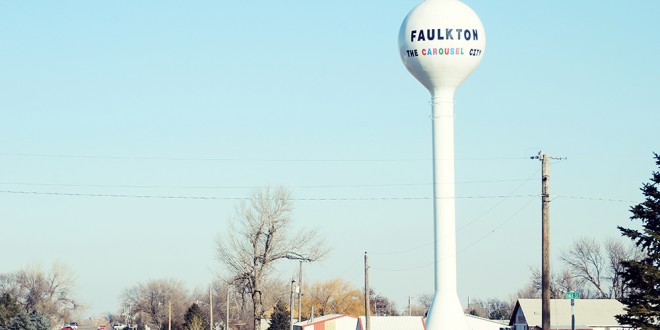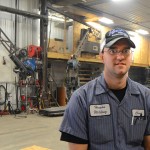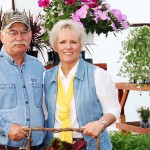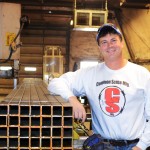Faulk County is working on revitalizing its community. Photo by Troy McQuillen
By Heidi Marttila-Losure, Dakotafire Media
Reporting by Garrick Moritz, Faulk County Record
A customer stopped by Common Sense Manufacturing in Faulk County a while ago and told business owner Kelly Melius that what the community needs is more businesses like Common Sense and Homan Welding—small shops that employ two people.
“I looked at him and I said, ‘I employ 10 people, and then 12 people in the wintertime when we’re really busy,’” Melius said. “And he looked at me and he goes, “‘Are you serious? You employ that many people?’”
Melius added that others have said similar things. “We’re just out in the country, so we’re not visible.”
Common Sense is going to be a good deal more visible soon, as its large new facility is going up along Highway 45. Melius expects that with more room to move they’ll be able to get orders out the door a little faster and ideally take on more new ones.
That customer might also be surprised to know Homan Welding is up to 10 employees as well.
“Some of our employees are from the area, some are new, some are native folks who have come back to live here because we’ve given them the working opportunity to do so,” said Chad Homan, co-owner of Homan Welding.
The Faulk County community itself could be said to be in a similar build-up period. A look at current census numbers shows that the county is facing a lot of the same challenges as its neighbors: Outmigration of young people and a declining population overall. But community leaders are also working on a whole series of initiatives that are moving the community forward a step or two at a time. They’ve taken enough of these small steps over the past three years that they are hitting their stride, and pretty soon they are going to break out on a run. If their momentum continues, they may well have forced those population numbers in another direction by the next census.
The list of things that Faulkton and Faulk County have accomplished in the past three years would be impressive for a town of 50,000 with a paid economic development staff. For a town with a population of just 737 and a county population of 2,367 with an all-volunteer economic development board, their list of accomplishments is pretty phenomenal:
- They’ve just been named a Home Address community, which will help them address housing needs by providing coaching as well as matching funds for a housing coordinator and a professional housing assessment. The program is sponsored by the South Dakota Rural Housing Authority.
- They are working on a Bush Foundation-funded project to do system-wide change in the community, which is based on cutting-edge thinking about how to foster such change.
- They are in a concerted effort to let the young people of the community know they are welcome back after high school, and are also reaching out to alumni to let them know they are welcome back as well.
- They worked with other communities in the region to apply for a U.S. Department of Agriculture grant to pay for a shared part-time economic development director, which they have now received.
- A meeting in September drew 80 people to discuss how to move the community forward.
- They are a site in the Dakota Rising program, which aims to help communities help their entrepreneurs, and four Dakota Rising entrepreneurial fellows have so far been selected from their community. The two fellows that went through the first year of the program added four permanent employees, increased their assets by 82 percent and upped their gross revenues by 147 percent. Two more fellows were added this year, and enthusiasm is high for other entrepreneurs to take part in the program.
Joel Price, chairman of the Faulkton Economic Development Board and superintendent of Faulkton School District, said their programs are now on separate tracks that somewhere down the road eventually meet in a common goal: a viable community.
“People love this community, they love the rural lifestyle, and they want to see it continue,” he said.
‘A shot in the arm’

Each graduate from Faulkton High School receives a mailbox filled with letters from leaders in the community, letting them know that they are valued and welcome to come back to Faulk County after they have gone out to see the world. “We’re trying to get the message out,” said Joel Price: “‘We really want you to come back.’” Photo by Troy McQuillen
Things didn’t click for Faulk County in their first efforts at community development. About six years ago, several residents traveled to the Rural Learning Center in Howard, S.D., to do some leadership development training, but afterward they still seemed to be spinning their wheels.
The message from there wasn’t wrong, Price said, but “people weren’t ready for it.”
Then, about three years later, they heard about the Dakota Rising program. Its emphasis on the business community struck a chord with the economic development board, and they decided to apply. Being accepted into the Dakota Rising program as well as working with its parent organization, the nonprofit Dakota Resources, has been a turning point for the community, Price said.
“I look at those two entities as really giving us a shot in the arm,” he said. “They opened some doors for us that we never would have known existed.”
The thing that’s unique about the Dakota Rising program is that it’s not just focused on helping businesses and entrepreneurs, or that it brings together businesses to network and share ideas, or that it works on capacity building in the community. There are other programs that do each of those pieces individually. What Dakota Rising does is bring together all those pieces into one program: Communities build their capacity as they work to help the entrepreneurs in their community succeed, all with the common goal of helping the community thrive.
“If real change is going to happen in the communities, it has to be grounded in the community,” explained Beth Davis, president of Dakota Resources. “It has to be the community members who care enough about their communities and the businesses in their communities to invest both capital and time and energy into creating an environment that nurtures and supports those businesspeople and their businesses. And that’s why Dakota Rising is grounded in place.”
Connecting community and entrepreneurs
Click on the images below to read more about Faulkton’s Dakota Rising entrepreneurs:
Focusing on entrepreneurs is not the way economic development was done 50 years ago, when the goal of many economic development groups was bringing outside businesses to town. Even today some communities still have a recruitment focus, but many have come to realize that strategy has really run its course. Manufacturing plants that are expanding today are more likely to relocate offshore than they are to come to a rural community, said Don Macke, director of strategic engagement at the Center for Rural Entrepreneurship, based in Lincoln, Neb.
“The opportunity for growing your economy has really shifted,” Macke said.
So, instead of looking outward and hoping that recruiting a business will revitalize an economy, the effort is flipped: Try to revitalize the economy that’s already in place, which will make the community more attractive for an outside business somewhere down the line.
“If you’re doing a good job of creating an environment where new business can start, existing business can grow, and you’re helping existing businesses that are struggling reposition so you can’t lose them, that … positions you well for other development,” Macke explained.
Davis said the reverse is also true: “If the community is not paying attention to the businesses that are already there, and supporting them, and investing in their opportunities for success and growth and profitability, they’re not going to be the kind of community that has the likelihood of attracting outside business.”
Macke stresses that it’s important to see the business sector as part of an ecosystem. “Businesses grow within the context of community,” he said. This means that the quality of schools, the appearance of a community, the attitude of a community, what it expects of its young people—all of those things and more affect whether businesses thrive.
Recruiting businesses can still be a part of an economic development strategy (“We need to be working all along the continuum of economic development,” Davis said) but for rural communities, the place to start is with what you have.
Faulkton has really taken that message to heart.
“The idea is that our job, the development side, is to foster what we already have, to maintain and then grow them,” said Price, adding that their focus now is on the four fellows currently in the Dakota Rising program. “Then it’s to feed the pipeline. It’s to keep that pipeline as full as we can so that we continue to keep fellows in there.”
Linda Bartholomew, a member of the Faulkton Economic Development Board, said the community recognizes that their future depends on these entrepreneurs. “You’ve got to reach out and encourage these people to realize a potential they may not know they actually have,” she said.
Starting an ascent
In 2006, a representative from the Northwest Area Foundation called Beth Davis at Dakota Resources and asked what it would take to move South Dakota to the next level in terms of community development. She said she thought a micro-lending program, which had been effective in developing countries as well as on Indian reservations, might work in South Dakota as well.
The micro-lending idea is still sort of a part of the program (Dakota Rising fellows receive $10,000 toward their development efforts, though it’s a grant, not a loan), but the idea evolved to become a more comprehensive community-based entrepreneur development system.
One significant part of the program is introducing community leaders and the program’s fellows to innovative thinkers and entrepreneurs from around the country.
“So we listen to these people talk and we read what they’ve written, and we begin to get ideas of our own,” Price said. “And we know that it’s based on real experience and that it works, and so then we try it here.”
Want to grow your own entrepreneurs? Beth Davis of Dakota Resources and Don Macke of the Center for Rural Entrepreneurship give their suggestions. See the story here.
Jim Moritz, editor of the Faulk County Record, gives his thoughts on the area’s improvements here.
Developers of Dakota Rising had an inkling that getting people working together through a shared-leadership approach on supporting entrepreneurs would lead to good things in other areas of the community. “And Faulkton is absolutely a shining star in this,” Davis said.
The program is fostering a transformation of culture that has widespread effects. For example, the Faulkton community has shifted from just thinking of their town to thinking about the county as a whole, and reaching out in practical, concrete ways to the people in outlying communities to get them involved in the conversation, Davis said.
But the most transformative changes so far have happened to the entrepreneurs in the program. The first two fellows were Chad Homan of Homan Welding and Lori Holt of Quilter’s Corner, selected in 2011.
Holt said the most beneficial aspect of the program is drawing on the brainpower of the group. “It really is helpful in identifying problem areas in your business and getting together with the others to determine areas that can be improved, and how we can improve them,” Holt said.
“It’s like therapy for businesspeople,” said Melius, who was selected as a fellow this year, along with Cindy Kopecky, owner of The Potting Shed. “You get to bounce ideas off people. If you’re having problems, you can talk to other people that, they aren’t even in your same industry, but yet, they’re businesspeople, they’re entrepreneurs … so they’ve either been in your shoes, or they have a pretty good idea of some advice that you can utilize.”
This help shows up in big ways—including growth in assets, employees and revenue—and in small ones. Melius, for example, has struggled to find enough employees. After advertising for months in several traditional classifieds, he came back from a recent Dakota Rising conference with the idea that he shouldn’t keep trying the same thing and expecting different results. He decided to try advertising on the online classified site Craigslist.
“Bam. Four or five calls in three days,” he said. And two of the new hires that have resulted from that are guys who already have commercial driver’s licenses, which will add flexibility to their delivery schedule.
The current fellows have found the process so beneficial they are happy to recommend it to other business owners.
“They are our best ambassadors,” Price said. “They are by far the best people we have for telling the story about themselves and also the Dakota Rising experience.”
Seeing the need
Why is it that Faulk County is moving forward when other rural communities are still struggling?
One answer is they know they have to work at it.
“We’ve been willing to open the door when you hear that knock,” Price said. “And I always remember (Thomas) Edison’s comment about why most people don’t open the door when opportunity knocks: he said because most of the time, it’s dressed in overalls and it looks like work. And I don’t think we’ve got people here that are afraid of work.”
Another answer is the shared-leadership approach that they have developed, which ensures that the work of development doesn’t all fall on one set of shoulders. That was important, for example, in September when several applications were due at once—dividing the workload ensured they could meet the application deadlines.
But this also points to the next step in Faulk County’s efforts: Getting more people involved.
“Now what we need to do is to take that energy and enthusiasm and spread that out and network with people in our community to get them excited about what we’re doing,” Price said. “In rural South Dakota … you’ve got a much smaller population base, so you need to get a larger percentage of those people involved in the process.”
Getting as many people to the table as possible is of practical importance to making sure the work gets done, but for those institutions such as local governments and schools that are invested in the future of the community it is also really a moral obligation, according to Macke of the Center for Rural Entrepreneurship.
Nobody else is going to better your community for you, he said. Those communities that are not actively working to improve are basically saying they are going to let fate decide what happens to them.
“And trust me,” Macke said, “my experience over 35 years is that communities that take on that responsibility in a serious and thoughtful way do better than ones that leave it to chance.”
That’s very clear to Faulk County leaders.
“If you do nothing you die,” Bartholomew said. “You have to be striving to move forward at all times.”
There’s no guarantee they’ll succeed, of course. But there’s a good chance Faulk County is altering their path in the direction of a brighter future.
“I guess five years from now, we’ll either be five years ahead or we’ll be five years older,” Price said. “I think that we’ll be five years ahead.”
What do you think?
Join the conversation at the Dakotafire Café!
Dakotafire’s new forum site has launched! Share your ideas on how to make our region a better place, comment on others’ ideas, and get prizes for participating. Some of the most popular ideas will be published in participating newspapers. Check it out at www.dakotafirecafe.com.
 Dakotafire Get your spark here.
Dakotafire Get your spark here.







